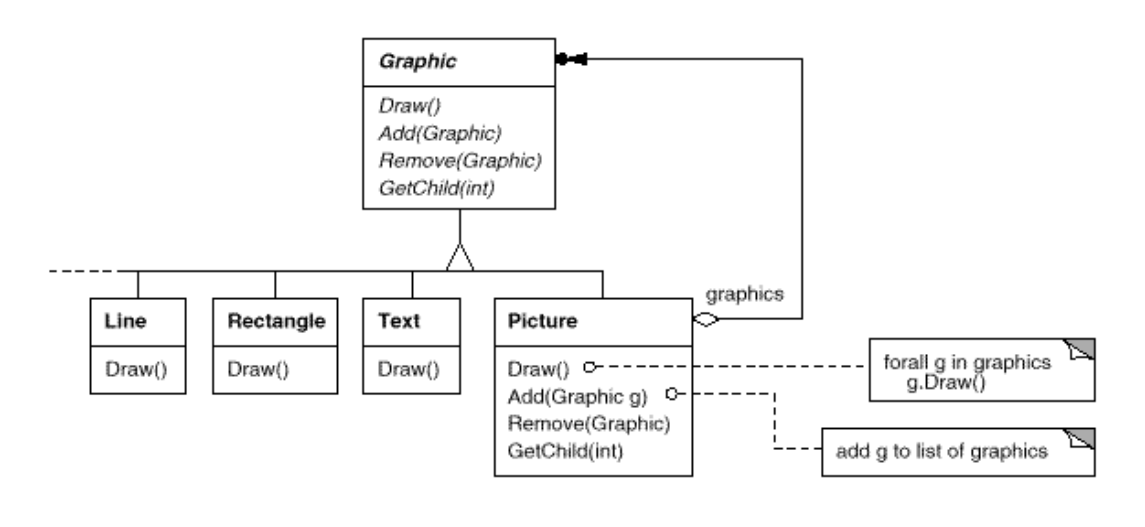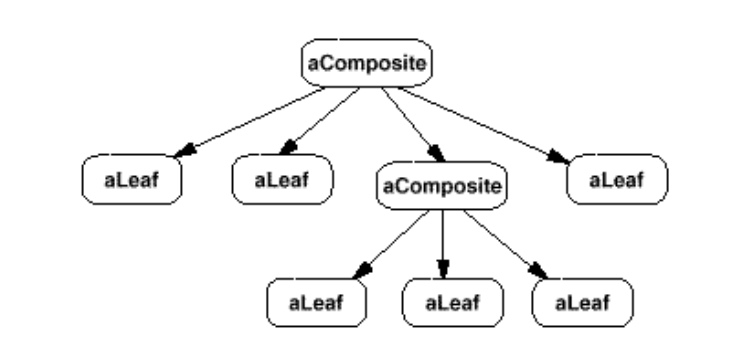8. Composite
- Intent:
- Compose objects into tree structures to represent part-whole hierarchies. Composite lets clients treat individual objects and compositions of objects uniformly.
- Applicability:
- you want to represent part-whole hierarchies of objects.
- you want clients to be able to ignore the difference between compositions of objects and individual objects. Clients will treat all objects in the composite structure uniformly.
- Structure:


- Participants:
- Component
- declares the interface for objects in the composition.
- implements default behavior for the interface common to all classes, as appropriate.
- declares an interface for accessing and managing its child components.
- (optional) defines an interface for accessing a component’s parent in the recursive structure, and implements it if that’s appropriate.
- Leaf
- represents leaf objects in the composition. A leaf has no children.
- defines behavior for primitive objects in the composition.
- Composite
- defines behavior for components having children.
- stores child components.
- implements child-related operations in the Component interface.
- Client
- manipulates objects in the composition through the Component interface.
- Component
- Collaborations
- Clients use the Component class interface to interact with objects in the composite structure. If the recipient is a Leaf, then the request is handled directly. If the recipient is a Composite, then it usually forwards requests to its child components, possibly performing additional operations before and/or after forwarding.
- Consequences:
- 1.defines class hierarchies consisting of primitive objects and composite objects.
- 2.makes the client simple.
- 3.makes it easier to add new kinds of components.
- 4.can make your design overly general.
- Related Patterns:
- Often the component-parent link is used for a Chain of Responsibility
- Decorator is often used with Composite.
- When decorators and composites are used together, they will usually have a common parent class. So decorators will have to support the Component interface with operations like Add, Remove, and GetChild.
- Flyweight lets you share components, but they can no longer refer to their parents.
- Iterator can be used to traverse composites.
- Visitor localizes operations and behavior that would otherwise be distributed across Composite and Leaf classes.
- Code Sample: Composite

public class TreeNode {
private String name;
private TreeNode parent;
private Vector<TreeNode> children = new Vector<TreeNode>();
public TreeNode(String name){
this.name = name;
}
public String getName() {
return name;
}
public void setName(String name) {
this.name = name;
}
public TreeNode getParent() {
return parent;
}
public void setParent(TreeNode parent) {
this.parent = parent;
}
public void add(TreeNode node){
children.add(node);
}
public void remove(TreeNode node){
children.remove(node);
}
public Enumeration<TreeNode> getChildren(){
return children.elements();
}
}
public class Tree {
TreeNode root = null;
public Tree(String name) {
root = new TreeNode(name);
}
public static void main(String[] args) {
Tree tree = new Tree("A");
TreeNode nodeB = new TreeNode("B");
TreeNode nodeC = new TreeNode("C");
nodeB.add(nodeC);
tree.root.add(nodeB);
System.out.println("build the tree finished!");
}
}
